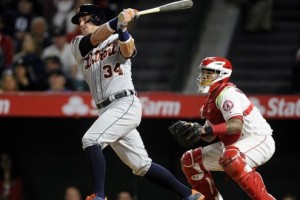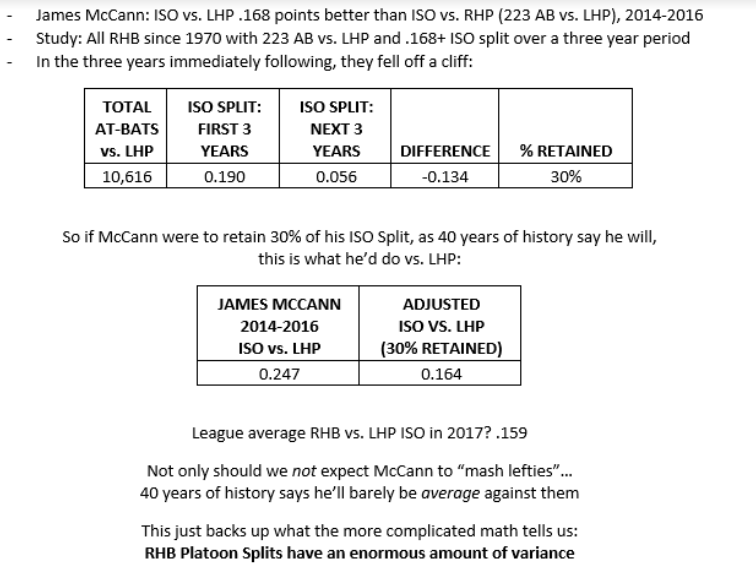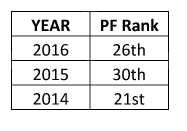Risers and Fallers: Volume 9
![]()
I’m excited to be back for another week of Risers & Fallers! Each week, I’ll break down a handful of players using advanced metrics, insights from my scouting background, and my DFS projection system THE BAT (available in the RotoGrinders Marketplace), which consistently beat Vegas lines last year.
I’ll examine guys whose stock is going up, guys whose stock is going down, guys who are perpetually underpriced or overpriced, guys who are worth paying a premium for, or guys who are just interesting and warrant some analysis on. If you guys have any suggestions for who you’d like to see in future articles, feel free to let me know.
Rising in the Court of Public Opinion… Incorrectly
James McCann, Fraudulent Lefty Masher, Detroit Tigers
The topic of “ James McCann: Lefty Masher” came up on Twitter again recently, and so it’s about time I put out some thoughts that can take up more than 140 characters at a clip. There’s no question that McCann has mashed lefties to this point in his career, but that’s a very different thing than saying McCann is a certified lefty masher or that he’ll continue to mash them going forward, which is all that matters for DFS. If you’re a subscriber to my Premium Content package, I did a video lesson that went into a lot of detail on why very few touts treat platoon splits properly. They have an enormous amount of variance, especially when we’re talking about right-handed hitters (like McCann!)
The premier sabermetric book, “The Book,” by Tom Tango, Mitchel Lichtman, and Andrew Dolphin goes into a lot of detail about platoon splits, why they’re noisy, and how we can quantify that noise. They go through the full math of how to account for the noise and project players properly, but the core takeaway comes down to this line: “A right-handed hitter needs around 2,000 plate appearances against left-handed pitchers before his measure platoon split can be considered reliable (in other words, the measured platoon split is more accurate than assuming the player has an average split). From a practical standpoint, right-handers are best assumed to have average platoon skills, unless one is willing to make the calculations needed to accurately estimate a player’s platoon skill.” This from the top sabermetricians in the public sphere, who have consulted and worked for multiple MLB clubs, and who (in Tango’s case) is driving much of the Statcast and related work at MLB.

Despite this, DFS players and touts continue to use raw, unadjusted platoon splits because, for whatever reason, they just choose not to believe this. We as human beings have an innate desire to find meaning in everything, even in things that have no meaning. We don’t like to believe that certain things are just random. This statement from The Book is also a difficult one to come to terms with, because it sounds so outlandish. 2,000 plate appearances against lefties translates to about 10 full seasons, and when you tell someone who isn’t very mathematically inclined that it takes 10 seasons before a righty’s splits are more predictive than just assuming he’s average, they outright laugh. Of course, they look silly doing so, because they’ve already been proven wrong.
A couple months back there was a discussion on Twitter where the non-math crowd all tried to jump to McCann’s defense. Because the math in The Book is incredibly complicated and not easily understandable, I ran some more simplified math using McCann’s specific situation and actual comparable players from the past four and a half decades in an attempt to appeal to them. Needless to say, it didn’t work, but it’s worth re-posting here:

For the sake of clarity, THE BAT uses the full, actual math for estimating platoon splits (not the math in this graphic), but because the full math exists and is real, when you look at specific examples such as these comparable historical players to McCann, what you find is heavy regression. Because that’s how baseball works. That’s how right-handed platoon splits work.
I mentioned earlier that people love to assign meaning to things, even things that have no meaning. Based on the laws of probability, though, there will always be outliers, things that happen simply by random chance because in the world, random chance exists and has to happen to someone. In baseball, as with many things in life, most stats follow a normal distribution:

Source: http://news.mit.edu/2012/explained-sigma-0209
If you never took a statistics class in college, a distribution is basically a graph of all the values of whatever you’re studying, and a normal distribution is one that forms a graph that looks like the one above. The middle has a big hump, and that’s where most of the datapoints are. The further you move away from the center, the fewer and fewer datapoints there are. Out at the very edges there are 0.1% of the datapoints. It’s a small number, but some datapoints by necessity are there, usually by random happenstance.
Not everything in the world is distributed normally, but many things are, especially in baseball. A real-world example is height. The average height of a man in the United States is 5 feet 10 inches. Most men are within maybe three inches of that, inside the giant hump in the middle of the graph. But there are some men who deviate more, and a very small amount who deviate a lot. On one end you’d have little people, on the other you’d have the tallest of the tall like Yao Ming. Yes, genetics play a part to some degree, but a lot of this is random. People can’t really help what size they are; they can’t do anything to be taller or shorter. You either grow to a certain height or you don’t. Yao Ming didn’t do anything special to be 7 foot 6. It just happened, because based on the laws of probability and normal distributions, someone has to be 7 foot 6, and it just so happened to be him. If you’re reading this, chances are you’re not 7 foot 6. You’re probably somewhere in the neighborhood of 5 foot 10. But there is some very small chance you could have been 7 foot 6; that small chance just hit for someone else instead of you.
The same is true of right-handed hitter platoon splits. Most hitters stay within the normal range, but someone has to be out at the end of the distribution. The mere fact that James McCann is out there doesn’t make him special. It doesn’t necessarily mean that he did something to deserve to be there. That distribution is going to happen whether James McCann exists in the world or not, and if it wasn’t him, it would be someone else, because someone has to fill that 0.1% at the end of the distribution. In all likelihood, McCann being there is completely random, because that’s how statistics work. It has to be someone, and it just happens to be him.
Maybe McCann will remain this good against lefties, but the odds of it are incredibly small absent additional information. We can never know with absolutely certainty how good any baseball player is, we simply have to make our best guess based on years of this game being played and the math supporting it. And based on that, McCann just doesn’t project to be much better than average against lefties going forward.
If you believe McCann’s true talent level against lefties is anywhere near what it’s been to this point in here career, please pitch me. Tell me why you believe he’s this good against lefties. Just don’t point to his actual stats against them, because they don’t count. They’re mathematically invalid. If there is additional information to consider, though, something about his swing that would lead us to believe he should have a wider split than a normal righty, that could have value. But I’ve never seen anything even remotely resembling this, only “look at his numbers!” And that’s just not good enough.
Rising in the Court of Public Opinion… But Not Enough
Freddie Freeman, 1B, Atlanta Braves
Freddie Freeman is a top-three hitter in baseball and has been since last year. While many are finally starting to realize that he’s elite, not everyone realizes just how elite he is. This is the list of the best hitters in the world, according to THE BAT:
1. Mike Trout
2. Bryce Harper
3. Freddie Freeman

This may seem aggressive given that Freeman just barely cracked a .400 wOBA (.402) for the first time in his career last season while there are a number of players like Paul Goldschmidt and Joey Votto who do it year after year and a number of younger hitters who are breaking out this season. (Side note: if you try to tell me Aaron Judge is the best player in baseball or anywhere near it, the door is that way.)
But as always, context is everything. My contention is that Freeman has always been elite, it’s just been masked by terrible context. Prior to this year, of course, the Atlanta Braves played in Turner Field, which was an extreme pitchers’ park. Here’s how it ranked for the past several years in terms of projected wOBA park factor for LHB:

Turner has been on the pitchers’ side for a while, and extremely so over the two years prior to this one. And not only was Turner horrible, but the NL East is one of the toughest divisions for hitters in terms of parks. Citi Field and Marlins Park are extreme pitchers’ parks. Nationals Park and Citizens Bank are roughly neutral. This has led to a very unfavorable mix of parks for Freeman in his career, and though the rest of the NL East hasn’t changed, the context in Atlanta certainly has.
While SunTrust Park’s hitter-friendliness has been exaggerated, it still ranks as the 10th best park for lefties in baseball. That’s a big upgrade for Freeman. The popular narrative is that the park was specifically “built for Freeman,” which is perhaps why he’s not quite getting the level of credit he deserves. “Oh, it’s the park inflating his numbers.” Yes, it has inflated them a little, but it doesn’t detract from just how great he is when you adjust his numbers accordingly. (THE BAT, of course, accounts for all of the prior context a hitter has faced and make the necessary adjustments.)
By first base standards, there are plenty of hitters who could at least come close to rivaling Freeman’s talent, especially in the right matchups. But now that Freeman is third-base eligible, it’s just not even fair. He’s so much better than literally everyone else who plays the position and ranks as the top option on almost every slate. One of the best GPP plays has been when Freeman gets discounted against an ace, like Max Scherzer and Stephen Strasburg a couple weeks ago. But when he’s facing a mediocre or weak pitcher, he’s a guy to consider spending up on in cash games whenever possible. He’s just that good.